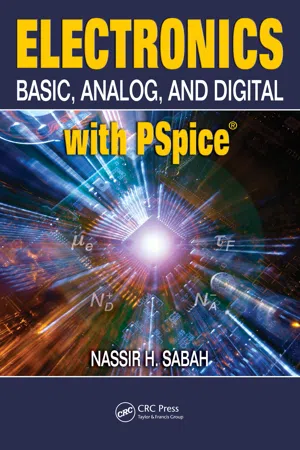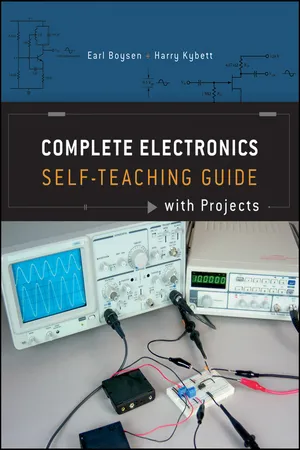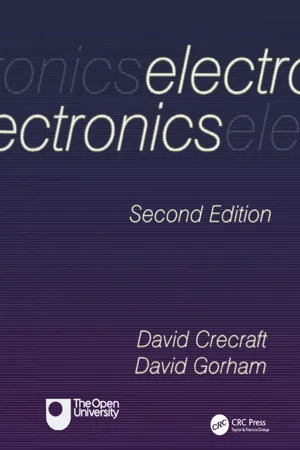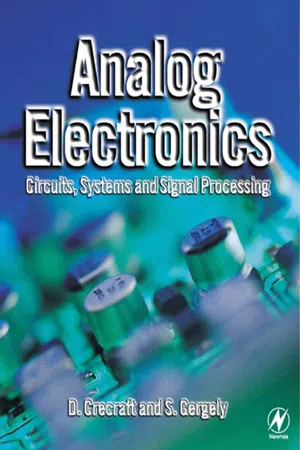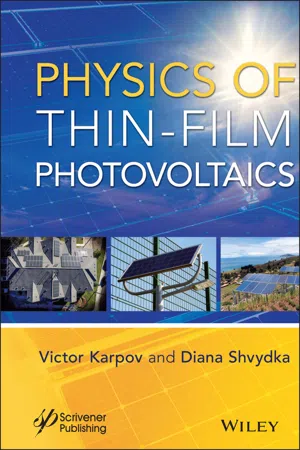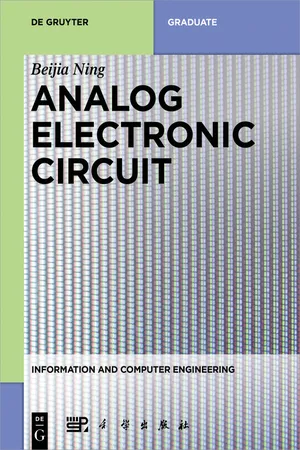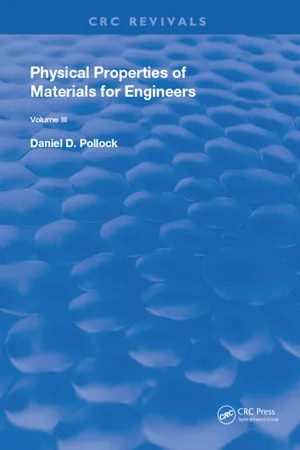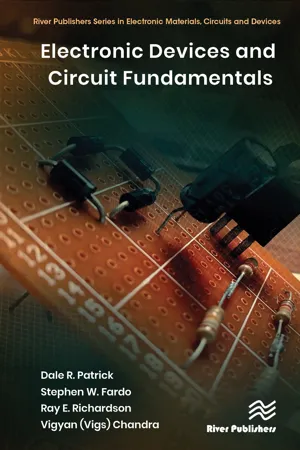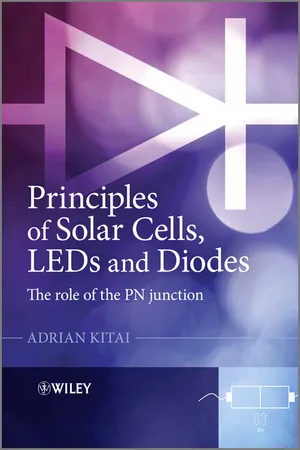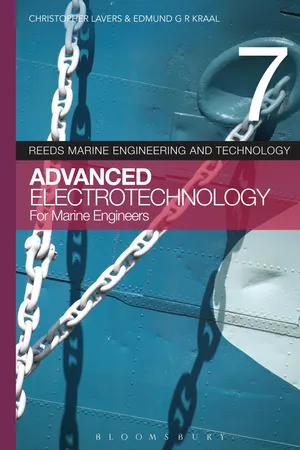Physics
Ideal Diode
An ideal diode is a theoretical electronic component that only allows current to flow in one direction, offering zero resistance in the forward direction and infinite resistance in the reverse direction. It is often used as a simplified model for analyzing and designing electronic circuits. In practical applications, real diodes exhibit some non-ideal characteristics such as voltage drops and finite reverse resistance.
Written by Perlego with AI-assistance
10 Key excerpts on "Ideal Diode"
- eBook - ePub
Electronics
Basic, Analog, and Digital with PSpice
- Nassir H. Sabah(Author)
- 2017(Publication Date)
- CRC Press(Publisher)
Just as linear passive elements are idealized in order to highlight their salient characteristics and the way they affect circuit responses, diodes are idealized for the same reasons. However, this idealization can take several forms, depending on the diode circuit under consideration. It is essential, therefore, to appreciate the nature and implications of the approximations inherent in these idealizations. This is true of electronic circuits in general so that gaining insight into the behavior of these circuits is particularly important. Except in relatively few cases, “exact” solutions are usually tedious and unwarranted, considering the usual tolerances on electronic devices. One should therefore strive to acquire a “feel” for electronic circuits in order to make “judicious” approximations. For more accurate results, simulations are usually resorted to. In this and the following chapters on electronic circuits, approximations and shortcuts are emphasized. More exact solutions are mentioned mainly to appreciate the fundamental principles involved and the nature of the approximations made.Learning Objectives
❖ To be familiar with: • The terminology associated with semiconductor diodes and their circuits. ❖ To understand:• The implications of the characteristics of Ideal Diodes and pn junction diodes.• The principles of operation of rectifier circuits and the methods used to smooth the output. • The application of zener diodes to voltage regulation. • The basic operation of voltage limiters, dc restorers, and voltage multipliers.1.1 Ideal and Practical Diodes
Ideal Diode
Definition: An Ideal Diode is a two-terminal device that behaves as a short circuit for current flow in one direction (the forward direction ) and as an open circuit for current flow in the opposite direction (the reverse direction ).The Ideal Diode behaves like an ideal switch that is controlled by the direction of current flow, much like a one-way, or no-return, valve that allows fluid to flow in one direction but not in the opposite direction.The symbol used in this book for an Ideal Diode switch has an unfilled arrowhead (Figure 1.1.1a ), the forward direction being that of the arrow, with the assigned positive directions of diode current and voltage as indicated. The i–v characteristic has the right-angled shape depicted in Figure 1.1.1b , and represents an ideal unilateral element, that is, an element that conducts in one direction only. The diode terminals are denoted as anode and cathode - Earl Boysen, Harry Kybett(Authors)
- 2012(Publication Date)
- Wiley(Publisher)
Chapter 2 The DiodeThe main characteristic of a diode is that it conducts electricity in one direction only. Historically, the first vacuum tube was a diode; it was also known as a rectifier. The modern diode is a semiconductor device. It is used in all applications where the older vacuum tube diode was used, but it has the advantages of being much smaller, easier to use, and less expensive.A semiconductor is a crystalline material that, depending on the conditions, can act as a conductor (allowing the flow of electric current) or an insulator (preventing the flow of electric current). Techniques have been developed to customize the electrical properties of adjacent regions of semiconductor crystals, which allow the manufacture of small diodes, as well as transistors and integrated circuits.When you complete this chapter, you can do the following:- Specify the uses of diodes in DC circuits.
- Determine from a circuit diagram whether a diode is forward- or reverse-biased.
- Recognize the characteristic V-I curve for a diode.
- Specify the knee voltage for a silicon or a germanium diode.
- Calculate current and power dissipation in a diode.
- Define diode breakdown.
- Differentiate between zeners and other diodes.
- Determine when a diode can be considered “perfect.”
Understanding Diodes
1 Silicon and germanium are semiconductor materials used in the manufacture of diodes, transistors, and integrated circuits. Semiconductor material is refined to an extreme level of purity, and then minute, controlled amounts of a specific impurity are added (a process called doping). Based on which impurity is added to a region of a semiconductor crystal, that region is said to be N type or P type. In addition to electrons (which are negative charge carriers used to conduct charge in a conventional conductor), semiconductors contain positive charge carriers called holes.- eBook - ePub
- David Crecraft(Author)
- 2018(Publication Date)
- CRC Press(Publisher)
Chapter 9 . This chapter concentrates on the simplest semiconductor device—the diode—which has one basic property: it conducts current much more easily in one direction compared to the other. This depends above all on the properties of pn junctions, which are junctions between two different types of semiconductor formed within a single crystal. In this chapter the manufacture and properties of pn junction diodes will be described, as a first step towards understanding the structure and operation of more complex integrated circuits.As well as forming a component of ICs, huge numbers of diodes are made as discrete components, and one of their biggest applications is for rectification, the conversion of a.c. into d.c. Hence Chapter 8 continues with a description of power supplies, particularly those which convert the a.c. mains into a stable d.c. voltage to power electronic circuits. Rectification is an important step in this, and is followed by smoothing and regulation. Two forms of regulation are described. Linear regulators are analogue circuits, which dissipate unwanted power, and are inefficient but easy to use. Switching power supplies, essentially digital, are much more complex, but are also much more efficient and versatile.8.2 DIODESThe fundamental characteristic of a diode is that it passes current more easily in one direction than the other. In the early days of electronics this behaviour was achieved by means of an evacuated tube containing two electrodes with the property that electrons could be emitted from one electrode to cross the gap between them, but not from the other. Nowadays diodes are ‘solid state’, usually consisting of a junction between two differently doped pieces of semiconductor such as silicon. They can be either discrete devices or part of much more complex integrated circuits. This basic property of passing current well in only one direction is fundamental to the operation of many analogue and digital circuits. - eBook - ePub
Analog Electronics
Circuits, Systems and Signal Processing
- David Crecraft, Stephen Gergely(Authors)
- 2002(Publication Date)
- Butterworth-Heinemann(Publisher)
5Diode and transistor circuits
5.1 Semiconductor diodes
The word diode means a two-electrode device. The two electrodes are called the anode and the cathode. As Figure 5.1 shows, current flows from anode to cathode when the anode voltage is positive with respect to the cathode voltage. Very little current flows when the polarities are reversed. So, the diode acts like a one-way valve in a pump. In circuit diagrams, the diode symbol has an arrow indicating the direction of easy current flow, as in Figure 5.1 . Diodes are used widely in electronic circuits, to rectify a.c. supplies and signals. Figure 5.1 shows an example of this, in which only the positive half-cycles of the a.c. supply are allowed to appear at the output of the circuit. Thus the output is always positive. With the aid of a capacitor this waveform can be turned into a close approximation of a d.c. voltage, for use as a d.c. supply for analog or digital circuits. More details of this process are given in Chapter 13 .Fig. 5.1 A simple rectifier circuit, using an Ideal Diode.How does the semiconductor diode work? It’s worth spending a little time understanding this, because its action is at the heart of the way transistors work. First, it is necessary to know what a semiconductor is. Typical semiconductors used for diodes and transistors are germanium (Ge), silicon (Si) and gallium arsenide (GaAs). Germanium was used in the early days of transistors, but is little used now. Gallium arsenide is used for the highest-frequency transistors in microwave applications such as mobile phones, and in high-speed digital circuits. But silicon is by far the most widely-used semiconductor.A pure (intrinsic) semiconductor is an almost perfect insulator at absolute zero temperature (0 K or −273.15°C). As the temperature is increased the conductivity increases. At room temperature the conductivity lies between that of an insulator and a good conductor, such as a metal. Hence the term semiconductor. The conductivity can be increased by doping the pure semiconductor with impurities, so creating an extrinsic semiconductor. In particular, in silicon two dopants are used namely phosphorus and boron. Figure 5.2 is a representation of a silicon crystal lattice. The atoms are effectively held together in a lattice structure by forces between them called covalent bonds. The presence of a small amount of phosphorus dopant is represented in the diagram by one atom of phosphorus. Silicon is a Group 4 element but phosphorus is Group 5 so, when a phosphorus atom is introduced in the lattice, it bonds with the adjacent silicon atoms, leaving one electron free to wander through the lattice. Electrons have a negative charge, so the free electrons give the semiconductor a free carrier of negative charge. For this reason, silicon doped with phosphorus is called ann -typesemiconductor. The other dopant commonly used is boron. This is a Group 3 element, so one of the bonds to the adjacent atoms in the silicon lattice is short of one electron. This deficiency is called a hole . It is possible for an electron of an adjacent atom to ‘fall’ into this hole, thus effectively moving the hole. In this way a hole can move freely through the lattice, just like an electron but with a positive charge. Such doped material is called a p - eBook - ePub
- Victor G. Karpov, Diana Shvydka(Authors)
- 2021(Publication Date)
- Wiley-Scrivener(Publisher)
Part II One-Dimensional (1D) Diodes and PVII. 1D Diode
The concept of diode underlies almost all the aspects of PV operations. Diode means a two-terminal device allowing an electric current to pass in one (forward) direction, while blocking it in the opposite (reverse) direction. Its nonlinear current-voltage (IV) characteristic is omnipresent in structures where the electron transport is affected by potential barriers. In reality, those barriers are associated with junctions. Here we discuss the simplest case of such a barrier to see how it leads to the diode type IV and which barrier parameters are important. In this part of the book, we consider only 1D structures and processes implying that there is no significant lateral nonuniformities and currents.It has become a standard in diode introduction literature to start with the notion of p-n junction [1–11]. However important, the latter concept appears somewhat oversold in applications to thin film PV at least. We would like to emphasize that the rectifying diode characteristics can be caused by practically any kind of junctions. Therefore, we decided to start with an example far away from the p-n situation to show how the diode IV becomes possible otherwise. We will touch upon the p-n junction concept later referring in the meantime to the ample high-quality literature presenting that concept.A. Metal-Insulator-Metal Diode
We consider a barrier formed by a contact of chemically different materials, so that the electron energy changes at their interface. The material where it is higher represents a potential barrier that the electron needs to overcome in order to penetrate that material. A barrier between a metal and vacuum represents the simplest case. By definition, its height equals the metal work function, i.e. the minimum energy required to extract an electron from the metal to the vacuum. In other words, it is the difference between vacuum level of energy and the Fermi level in the metal.Fig. 7 - eBook - ePub
- Beijia Ning, Beijia Ning(Authors)
- 2018(Publication Date)
- De Gruyter(Publisher)
D is beyond the voltage drop across the diodes. The defined direction of conventional current for the forward voltage region matches the arrowhead in the diode symbol.For the forward- and reverse-bias regions, the general characteristics of a semiconductor diode can be defined by the following equation, which is referred to as Shockley’s equation:- When in the reverse-biased condition, the direction of I S is against the symbolic direction of I D . Also, the reverse current rises quickly and soon reaches the saturation level. However, for a commonly-used diode, the actual reverse saturation current will normally be measurable as larger than that from the curve.
Fig. 2.4: Forward-bias condition of s semiconductor diode, (a) Internal carrier distribution under forward-bias condition, (b) Electrical symbols of forward-bias condition.Fig. 2.5: Silicon semiconductor diode characteristics.I D=I S()e− 1V D/ nV T(2.1)where I S is the reverse saturation current; V D is the applied forward-bias voltage across the diode; n is an ideality factor, which is a function of the operating conditions and physical construction, ranging between 1 and 2 depending on a wide variety of factors (n = 1 will be assumed throughout this textbook unless otherwise indicated). The voltage V T is called the thermal voltage and is determined byV T=k Tqwhere k is Boltzmann’s constant = 1.38 × 10−23 J/K; T is the absolute temperature in Kelvin = 273 + the temperature in °C; q is the magnitude of electronic charge = 1.6 × 10−19 C.2.3The Schottky diode
Instead of generating a semiconductor–semiconductor junction as in conventional diodes, a metal–semiconductor junction can also be formed between a metal and a semiconductor. Thus, a potential energy barrier for electrons is generated, called the Schottky barrier after Walter Schottky. Schottky barriers have rectifying characteristics, suitable for use as a diode. The electronic symbol of the Schottky diode is shown in Fig. 2.6 [14 - eBook - ePub
- Daniel D. Pollock(Author)
- 2018(Publication Date)
- CRC Press(Publisher)
11.9 SEMICONDUCTOR DIODE DEVICESThe devices discussed in the following sections have been included as being representative of some of the more commonly used diodes. The intent is to demonstrate many of the more important physical mechanisms involved, rather than to provide a catalogue of devices.An important class of semiconductor diodes is based upon single p-n junctions. The readily controlled charge carriers and electric fields in the depletion zones in the neighborhood of junctions make these devices possible (Section 11.6). The variations in the behaviors of the carriers and the internal electric fields when influenced by voltages, radiation, and other external effects determine the properties, type, and applications of the devices. Since the junctions are small, and the reactions take place near them, such devices can be, and are, made to be very small.The graphs are intended to show functional relationships, rather than actual values because of the variations in the properties of devices made by different sources. 11.9.1. Semiconductor Diode RectifiersThe polarity of the power supply is important in many electronic circuits. Power of the wrong sign can incapacitate many devices. Protection against this event may be obtained by the use of two oppositely oriented rectifiers in parallel between the supply and the circuit. Current of the wrong sign will be blocked by one of the rectifiers (negatively biased) and the circuit will be protected.In a comparable way, excessive voltage (overvoltage) can be eliminated by means of two oppositely oriented rectifiers in series between the input and the circuit. These limit the input voltage to the desired value without entering into the circuit.Two oppositely oriented rectifiers in parallel with each other, and connected in parallel with a suitable resistor across the terminals of a circuit, can provide protection against excessive current. In such an event, the rectifiers limit the excess current and allow only the desired amount of current to enter the circuit. - eBook - ePub
- Dale R. Patrick, Stephen W. Fardo, Ray E. Richardson, Vigyan (Vigs) Chandra(Authors)
- 2023(Publication Date)
- River Publishers(Publisher)
2 P–N Junction Diodes P–N junction diodes are used rather extensively in the field of electronics. Radio, television, industrial control, computers, home entertainment equipment, and electrical appliances are a few of the applications. Diodes are probably the simplest of all electronic devices because only two leads, or electrodes, are used in their construction. In general, diodes are used to control the conduction of electric current. Functionally, diodes are unidirectional, which means that they conduct well in only one direction. Diodes, therefore, are designed to block or pass current according to the polarity of voltage applied (biasing). This permits the diode to be used as a switch. Diodes can also be used to alter the direction of current passing through other electronic parts. In this application, the diode is used to change AC to DC, a process called rectification. Rectification is one of the most common applications of the diode and is covered in Chapter 4 − Power Supply Circuits. Other functions of the diode are the operational basis of more complex electronic devices. Transistors, integrated circuits, and other solid-state devices are constructed by the same techniques used to produce diodes. A person working in electronics must, therefore, be familiar with the characteristic operation of this device. P–N junction diode theory is the subject of this chapter - eBook - ePub
Principles of Solar Cells, LEDs and Diodes
The role of the PN junction
- Adrian Kitai(Author)
- 2011(Publication Date)
- Wiley(Publisher)
Figure 2.1 . There are several basic features of the diode including the following:a. a metal anode contact applied to a p-type semiconductor forming a metal-semiconductor junction;b. a p-type semiconductor;c. a p-n semiconductor junction between p-type and n-type semiconductors;d. an n-type semiconductor;e. a metal cathode contact applied to an n-type semiconductor forming another metal-semiconductor junction.Figure 2.1 The p-n junction diode showing metal anode and cathode contacts connected to semiconductor p-type and n-type regions respectively. There are two metal-semiconductor junctions in addition to the p-n semiconductor junction. The diode symbol and two examples of diode applications in circuit design are shown. The diode logic gate was used in early diode-transistor logic solid state computers popular in the 1960s but has been replaced by transistor-based designs that consume less power and switch fasterThe purpose of this chapter is to cover the principles of the p-n junction diode. Originally the semiconductor diode was used to provide current flow in one direction and current blocking in the other direction. It found widespread application in early logic circuits as a clamping device and as a logic adder. It is widely used as a rectifier in power supplies and as a detector in radio circuits. Two of these circuit applications are illustrated in Figure 2.1 . The applications of specific interest to this book are the more recent derivatives of the semiconductor diode that have become widely used semiconductor diode devices for light emission (LEDs) and for solar power generation (solar cells).The principles underlying diode operation in general will be covered in this chapter.Solar cells and LEDs can be fabricated from a range of both inorganic and organic semiconductor diode materials. Chapters 4, 5 and 6 will cover device designs and specific fabrication methods, and build on these principles to further develop topics that are specific to solar cells and LEDs based on inorganic as well as organic semiconductors. A good understanding of all diode-based semiconductor devices requires a fundamental understanding of the p-n junction diode including the electrical contacts made to the diode. - Christopher Lavers, Edmund G.R. Kraal(Authors)
- 2014(Publication Date)
- Thomas Reed(Publisher)
figure 11.7 . If a potential is applied so the P-type end is +ve with respect to the N-type end, then a current due to this potential consists of either electrons moving right to left or holes moving left to right. Since the N-type side contains free electrons and the P-type side contains holes, current will readily flow across the junction. If the applied voltage is reversed, the current direction would occur either by electrons moving from left to right (and there are no electrons available), or by holes moving from right to left (similarly there are no holes available) and so no current can flow.▲ Figure 11.7DIODE CHARACTERISTIC. If a test circuit is arranged, as in figure 11.8a , and the results of applied voltage plotted against diode current for increasing current values, the semiconductor junction is observed to act like a thermionic diode when the latter conducts. The general shape of the current/voltage characteristic is shown by figure 11.8 , it resembles the vacuum diode, but it is noted that when the applied voltage is reversed, a minute reverse current will continue to flow. This reverse current is due to the release of electrons by ionisation, i.e. thermal agitation which gives the P-type side a few electrons and the N-type side a few +ve holes. If the reverse voltage becomes too large, there is a breakdown of the covalent bond structure and the current will increase very rapidly. For a semiconductor diode, the electrode to be connected to the +ve terminal of the supply for forward conduction is clearly marked for this reason and must be connected correctly. As for a diode valve the terms anode and cathode are used accordingly.▲ Figure 11.8The characteristic shown is typical of a small semiconductor diode. Note the change of current scale for the reverse graph, which shows the limit where the reverse current saturation value is broken down, where the ‘zener effect
Index pages curate the most relevant extracts from our library of academic textbooks. They’ve been created using an in-house natural language model (NLM), each adding context and meaning to key research topics.
Explore more topic indexes
Explore more topic indexes
1 of 6
Explore more topic indexes
1 of 4
